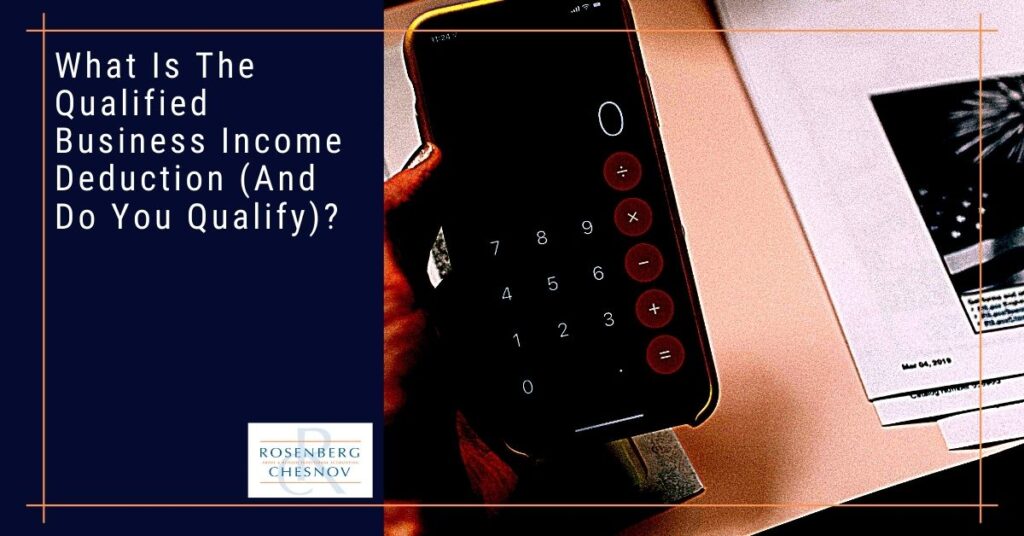What does the Qualified Business Income Deduction allow me to Deduct?
In short, you may deduct 20% of qualified business income that you earn from a partnership, S-corporation, or LLC from your taxable income.
In the case of a partnership or S-corporation, the deduction applies at the partner or shareholder level.
Now we move on to the caveats.
- The business must operate within the United States.
- There are special rules for agricultural or horticultural cooperatives.
- Income from rental real property held for investment and reported on Schedule E (Form 1040) is not eligible for the QBID.
- Income from a real estate business does qualify (so if you own a business that rents property, that business income qualifies).
- The QBID reduces your taxable income, not your adjusted gross income (AGI).
- You must still pay self-employment tax on the deducted amount.
- The deduction is available whether you itemize your deductions or take the Standard Deduction.
What constitutes Qualified Business Income (QBI)?
QBI is the net income, gain, deduction, and loss you earn through your business. It includes all operating income and income from rental activities (unless this is income from property held for investment and reported on Schedule E).
The net amount is the amount after you have included any deductions, including:
- Self-employment tax deduction.
- Self-employment health deduction.
- Contributions to a qualified retirement plan.
- Unreimbursed expenses.
- Charitable deductions made by the business reported on Schedule K-1, and you claim as an itemized deduction on Schedule A.
- The interest expense you may incur to purchase a partnership or ownership interest in an S-corporation.
You should not include these items as Qualified Business Income:
- Any item used to calculate long-term capital gain or loss.
- Dividends or income equivalent to dividends.
- Interest income unless it is appropriately allocated to the trade or business.
- Guaranteed payments from a partnership.
- The income you earn as an employee.
Once you calculate your Qualified Business Income, the next step is to check the income limits and thresholds. Income above a certain level will reduce your Qualified Business Income Deduction.
Income Limits and Thresholds for the Qualified Business Income Deduction
This section goes through the income limit and thresholds for the QBID. If your income exceeds the threshold amount, there is a formula to calculate your deduction. If your income does not exceed this threshold, you don’t have to worry about the formula.
Here are the 2021 thresholds and phase-out ranges. This is all taxable income, not Adjusted Gross Income:
| Single, Head of Household, | Married Filed jointly | Married Filed Single | |
| Threshold Amount | $164,900 | 329,800 | 164,925 |
| Phase-in Range (for SSTB, see below) |
$164,901 – $214,900 | 329,801 – 429,800 | 164,926 – 214,925 |
| Full Limitation Applies (per W-2 Wages/Property Limitation, full exclusion of SSTB) |
$214,901 and higher | $429,801 and higher | $214,926 and higher |
How to calculate the limitation
This limitation is called the form W-2 Wages/Property limitation, and it depends on two factors, the W-2 wages paid by the business and the business’s capital expenditures. The limit caps the total deduction. It is the greater of:
- 50% of the Form W-2 wages paid by the business, or
- The sum of 25% of the Form W-2 wages paid by the business, plus 2.5% of the unadjusted basis of qualified property that the business acquired.
The best way to understand how the exclusion works is through an example:
Assume Mike operates a sole proprietorship that makes beef jerky. His Qualified Business Income for 2021 was $180,000, and his taxable income is $225,000. The business bought some new equipment for $100,000 and put it into service in 2021. Mike has one employee and paid a total of $20,000 in Form W-2 wages.
Mike’s unadjusted QBID is 20% of $180,000 or $36,000.
However, because his income is greater than $214,901, he is subject to the Form W-2 wages/property limit, which is the greater of:
- 50% of Form W-2 wages. Mike pays $20,000 in W-2 Wages, so 50% of that is $10,000
AND
- 25% of W-2 wages plus 2.5% of his capital investment. 25% of 20,000 is $5,000. He made a $100,000 capital investment, 2.5% of that is $2,500, $5,000 plus $2,500 is $7,500.
Mike’s limit is the greater of $10,000 or $7,500, so the total amount he can deduct is $10,000.
Qualified trade or business
The deduction applies to qualified trade or businesses.
A qualified trade or business includes any trade or business for which you may deduct ordinary and necessary business expenses.
The definition expressly excludes:
- Business conducted through a C-corporation.
- Wages earned as an employee, and
- Specified Service Trade Businesses if your income exceeds the threshold above.
The Specific Service Trade or Business (SSTB) exclusion
The Specific Service Trade or Business (referred to as SSTB) exclusion is an important one.
If your income is above the threshold but below the full limitation amount, then SSTB income phases out. Once you reach the full limitation amount, SSTB income is excluded entirely.
An STTB is any trade or business providing services in the following fields:
- Health.
- Law.
- Accounting.
- Actuarial science (assessing financial risks for insurance and finance).
- Performing arts.
- Consulting.
- Athletics.
- Financial services.
- Investing and investment management.
- Trading.
- Any business where you receive income for endorsing products or services, for the use of your image, likeness, name, signature, trademark, or identity.
- Appearances on television, radio, or any other medium.
If your taxable income is within the phase-out range, then you calculate your percentage of the phase-out, multiply that by your income, reduce the qualified business income by that amount and take 20% of the remainder.
Got it?
Again, an example helps here. A lot:
Assume June is an attorney with a taxable income of $178,200. Her Qualified Business Income is $150,000. Her business as a lawyer is an SSTB, and her taxable income is over the threshold but below the full exclusion limit.
This is how she calculates her reduction:
First she calculates the income amount that exceeds the threshold: $178,200 – $164,900 = 13,300
Then she calculates this as a percentage of the phase-out amount, $50,000 (this would be $100,000 if married filing jointly): $13,300/$50,000 = 26.6%.
She multiplies the 26.6% times her total income ($178,200) to get the amount by which she reduces her qualified business income, $178,200 times 26.6% = $47,401.
Her qualified business income is $150,000, so she subtracts $47,401 from $150,000 to get $102,599.
Her QBID is 20% of the $102,599 remaining, so $20,520.
If her income is above the full limitation, then she does not qualify for the QBID.
Is the QBID for you?
If you have business income this is worth looking into. A 20% tax deduction will make a big difference in your taxes. The calculations can get complicated so if you would like us to go through this with you, set up a time to talk below. Let’s see if you qualify for this deduction.
The IRS has more information available here as well.
Would you like some help?
If you are a client and would like to book a consultation, call us at +1 (212) 382-3939 or contact us here to set up a time.
If you aren’t a client, why not? We can take care of your accounting, bookkeeping, tax, and CFO needs so that you don’t have to worry about any of them. Interested? Contact us here to set up a no-obligation consultation.
Is the QBID for you?
Interested in receiving updates in your mailbox? Check out our newsletter, full of information you can use. It comes out once every two weeks and you can register for it below.





